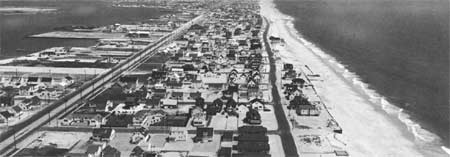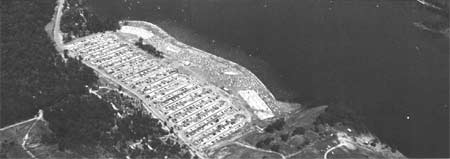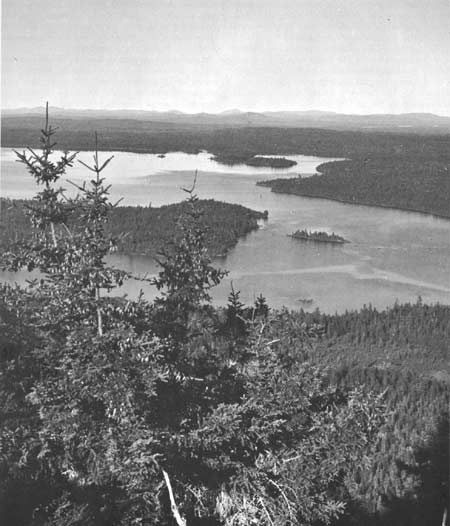.gif)
Parks for America
MENU
|
Parks for America
|

|
THE NORTHEAST
The Northeast region encompasses a wide range of physiographic and socioeconomic variation within a relatively limited land area. The outdoor recreation resources also are widely diversified, with the adequacy of existing facilities ranging from woefully insufficient to adequate. The contrast between the quiet solitude of the north woods of Maine and the crowded New Jersey and New York beaches typifies this diversity.
The nine States in the Northeast constitute the most densely populated region in the country, with 25 per cent of the total population of the contiguous States residing on 5 percent of the land area. Because the majority of the people are concentrated in the east coast "megalopolis" that sprawls across State lines, provision for outdoor recreation becomes regional in importance rather than intrastate. The fine ocean beaches of Long Island and New Jersey are an attraction for the inland dwellers as well as the coastal residents. The mountains of Pennsylvania, New York, and New England likewise are of interstate importance in meeting outdoor recreation needs. With a steadily improving network of interstate highways interlacing the whole Northeast region, regional planning for outdoor recreation becomes increasingly important.
Outdoor recreation and tourism produce relatively high income, and in several areas outdoor recreation is the prime income producer. A few areas have been chronically economically depressed. Fortunately, in the majority of these areas outdoor recreation and tourism can, with intelligent planning, be expected to contribute substantially toward reinforcing the economy.

|
| Developments preempt the shoreline at Grant Beach, N.J. . . . |

|
| State parks like Gifford Pinchot in Pennsylvania fill to over-flowing . . . |

|
| As eastern urban and suburban areas like Levittown, Pa., expand across the landscape. |

|
| Yet, wild corners of the Northeast, like the Alagash country of Maine, still offer unspoiled environment for recreation. |
The pattern of outdoor recreation in the region reflects a wide variety of preferences and opportunities for recreation activities. Many of these activities are related to water. Preferences are as varied as the opportunities offered—seashore, lakeshore, or stream-side—rocky or sandy—forested shoreline of mountain lake or sunny, breeze-cooled seacoast—crowds, isolation, or the range between—and a wealth of historical interest.
The recreation facilities of the region receive extremely intensive use in the summer. This use is most heavily concentrated in the major vacation areas in Maine (especially along the coast), in New York (the Adirondacks and the St. Lawrence River), and in other similar areas. Closer to the population centers, weekend recreation is concentrated in such areas as the New Jersey and Long Island beaches, the Catskill and Pocono Mountains, and Lake George in New York. Masses of people stream to these areas from Friday evening until Sunday, at which time use decreases to a relatively small number of permanent, summer, and 1- or 2-week vacation residents. Highways and other transportation facilities serving these areas are overtaxed at the times of arrival and departure.
Existing public park and recreation areas and facilities vary considerably in their adequacy to meet the needs. The influx of vacationers magnifies the needs in several of the States for recreation areas and facilities far beyond what would be required by their residents alone. In some cases the need for day and weekend use has been recognized, and attempts have been made to provide facilities to accommodate this need. In other areas no real evidence of the recognition of this need exists. In every case the sum total of the effort put forth to date has fallen short of satisfying the demand.
Private enterprise makes an important contribution in providing facilities and services to visitors in several parts of the region. Frequently a major resource in public or quasi-public ownership is the prime drawing attraction, with numerous satellite developments springing up around the area to provide services ranging from the essential to the luxurious. Privately owned forest lands have been receiving increasingly heavy recreation use in the past few years. Several private organizations have as their objective the preservation of outstanding natural areas.
The major shoreline areas are privately owned, and public use is restricted. The storm along the Atlantic coast on March 6, 1962, served to point up the susceptibility of some of the past developments to flooding and destruction. The extent of the havoc wreaked upon structures on the barrier reefs and the degree to which natural, stabilized dunes withstood the storm have strengthened the justification for more preservation of natural beach environment.
The region has varied and abundant resources sufficient to satisfy the full range of recreation needs. The missing ingredient is an extensive land acquisition program, with provision for the adequate development of facilities. Existing areas should be rounded out and facilities improved. The need for day and weekend recreation opportunities is extremely pressing. The preservation of open space for recreation, esthetic, fish and wildlife, watershed, and other conservation purposes in and near urban centers has become imperative.
To help satisfy the need for close-in recreation areas, attention should be given to remaining natural and historic sites and the few remaining shoreline opportunities. Artificial lakes can go far toward satisfying needs for intensive recreation. Multiple-purpose reservoirs can, of course, play a major role, but in many areas, impoundments with recreation as the primary purpose may be economically feasible. With the application of modern water purification practices, many water-supply reservoirs—still restricted—might be made available to meet needs.
Man has a very definite need for large, relatively remote areas where he can sense the solitude and inspiration of pristine nature. To supply this need adequately throughout the Northeast region, interstate and regional planning is required.
The Appalachian mountain chain offers the most significant opportunity for supplying the needs for more remote natural areas. Lying near the east coast "megalopolis" and the growing urban, industrial complexes in western Pennsylvania and central New York, the mountains are even now reasonably accessible to multitudes of people. If the public can act quickly enough, acquisition of recreational lands in the mountains can logically serve as the backbone of a concentrated effort to protect and develop important outdoor recreation resources.
Although private enterprise should and undoubtedly will continue to play a major role in providing services required by recreationists, its ability to protect the essential central attracting resources is limited. Public efforts must be intensified to preserve large areas in a relatively natural condition. The opportunity to do so, particularly in places that are easily accessible to urban centers, is rapidly passing.

|
| Historic monuments hallmark the Northeast. Paul Revere's statue stands near Old North Church, that is part of a complex of private and public properties proposed for group designation as Boston National Historic Sites. |
NEXT >>>
|
|
Last Modified: Mon, Sep 6 2004 10:00:00 pm PDT
parks_america/northeast.htm
 Top
Top